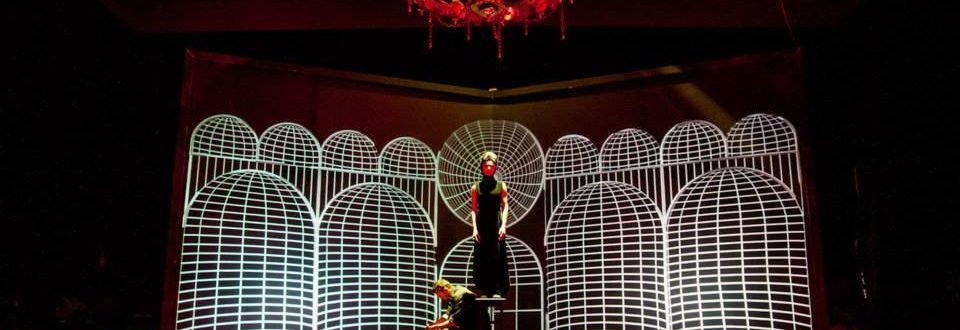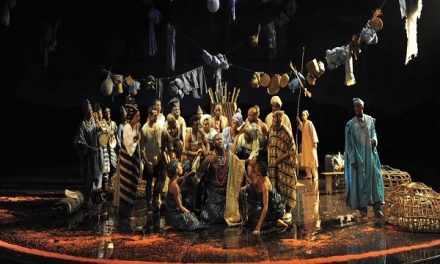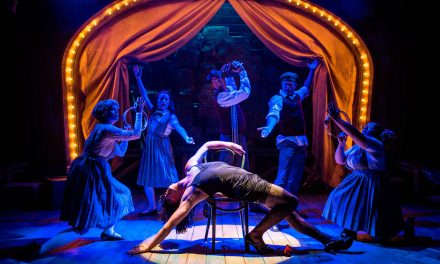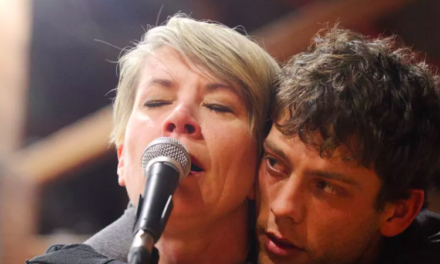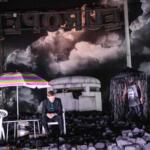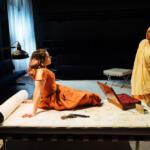The theatre landscape in Ukraine is diverse and contradictory. Presently, there are more than 120 theatres (state-funded and independent) functioning here, and the audience numbers are around 5.6 million per year (in accordance with government statistics). This is not including touring, one-time shows, and interdisciplinary practices.
However, whatever the figures say, Ukraine can be called a country where the audience/society has not yet decided what “theatre” is and where its boundaries are. More precisely, what can or can’t be considered worth the price of a ticket. This is because, even until fairly recently, Ukraine was the arena of a powerful rivalry between two ideologies: the “Soviet-Eastern” identity came into conflict with the “Western,” “European” one. In fact, both poles had little in common with the real, always too “voluminous” history of society. Both are equally myths deprived of unpleasant details, and each side actualized these myths in its own way through the arts.
Today, society is also heterogeneous, so the modern theatrical map of Ukraine could be compared to a group of islands. It seems that today’s theatre field summarizes the conceptions of theatre used in different times: from the director’s repertoire theatre of the 1970s, the Soviet staffing network and the understanding of the production as “a work (…) created on the basis of dramatic, musical-dramatic or literary material that has a single intention” (The Law Of Ukraine “On Theatres And Theatrical Business” No. 26, article 350), to the design experimental theatre outside the black box, without any literary “base” or the conventional crew (playwright/director/actor).
What kind of image you will have, depends on which island you get on.
19th–mid-20th century: professionalization under censorship and restrictions
It goes without saying that the nature/character of Ukraine’s culture for many centuries was determined by its “buffer” position between the West and the East. Now I would like to return for a short while to the point when in Ukraine, according to many researchers, the phenomenon of professional theatre appeared and took shape. It happened late, at the end of the 19th century; much later than in countries that had experience of independence.
The first professional theatre is considered the theatre of Marko Kropivnitskyi (Coryphaeus’ Theatre; 1882) and could be distinguished from a number of amateur activities thanks to:
a) commercialization; here the company has the opportunity of regular earnings
b) the formation of a special style of presentation and play; the theatre was the institution that directly trained the personnel for work
c) a special stable “triumvirate”: the author–the stage–the audience, and effective communication with the audience
As soon as the first professional theatre in Ukraine began work, it immediately found itself facing a number of stringent restrictions (Ems Ukaz of 1876). As the theatre of one of the nationalities within the Russian Empire, whose language is “illegitimate” and limited, mainly to domestic use, any utterance that resembled criticism of the system or any analysis of society was banned. The Ukrainian theatre, ultimately, did not have the opportunity to show anything to the theatre-goer, except musical comedies and domestic melodramas (later, in the period of the USSR, the situation would not be much different). Hence the palette of musical-dramatic genres presented to the audience (melodrama, comedy), and a stable system of popular theatre.
Ukrainian director, theoretician and actor Les Kurbas was the first who undertook expanding the scope of such a domestic theatre in the early 20th century. Not being familiar with Vsevolod Meyerhold, he developed the ideas of formal and symbolist theatre. He coined the term “peretvorennia” (transformation), which means working with the audience’s perception through metaphors and associations without the “direct talk” of the domestic theatre. In 1922 in Kyiv he created Berezil, the first theatre in Ukraine functioning on the studio principle, which was aimed not so much at the regular production of performances, as at the acquiring of new experience and a new arsenal of expressive means. The actors of Berezil taught the history of the ancient theatre, mastered the plastic of the Indian theatre or Japanese “Noh” theatre, and worked with the dramaturgy of German Expressionism.
Despite the “waves” of repression, the Soviet period is important in its own way for the development of the Ukrainian theatre. During this time the theatre, like all other arts, was understood primarily as a tool for shaping the position of citizens, the consolidation of society along the chosen course. Theatrical art received enormous financial support from the state here–while suffering from a number of barriers to free development–and was popularized in every possible way. During this particular period the network of professional theatres was created throughout Ukraine (a typical music and drama theatre can be found in almost every city), as well as a network of universities and academies for professional training (Kyiv National I. K. Karpenko-Kary Theatre, Cinema and Television University, National Conservatory), and a number of communities for professionals-specialists (National Union of Theatre Artists of Ukraine, Union of Composers, Union of Writers, etc.).
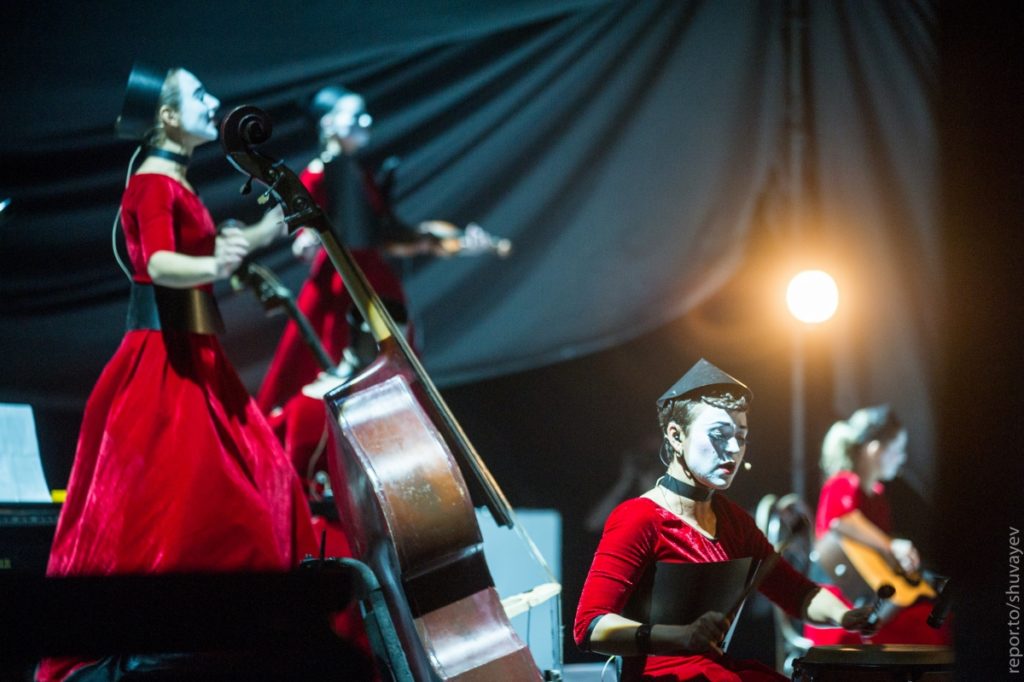
Dakh Daughters at Gogolfest 2015 (© report.to)
Independence: diversity and “spacewalk”
With the acquisition of the country’s independence in 1991, the situation changed radically and allowed theatre to choose independently its own course. In the 90s, for the first time after Berezil, Ukraine saw a new boom of the studio movement, private microstages and small author’s studio theatres. Some of them, because of the lack of support from “outside” and the need to fill the cash register, turned into ordinary chamber repertory theatres after a year or two (and soon disappeared altogether), while others gave a breath of life to the new art, which in earlier times simply did not exist in Ukraine.
This time is associated not only with the change in the forms of organization of the theatrical business (state/private), but also with aesthetic discoveries. State theatres, whose work mainly consisted of the production of classics on large stages, could not always capture and portray that particular state of crisis, the feeling of anxious instability and chaos that arose in a society which was recovering from the Soviet past, but still did not know anything about its future. A group of directors felt keenly the exhaustion of literary/verbal theatre: Andrii Zholdak, Oleg Liptsyn, Valerii Bilchenko, Vlad Troitskyi.
The last of them, Vlad Troitskyi, a director and producer, managed to create a whole system for producing an alternative culture of performing arts in Ukraine. In 1994 the Center for Contemporary Arts Dakh appeared in Kyiv (it is still functioning today). It became not just one of the most legendary studio theatres, but also an educational platform, a school for the education of actor-performers, a mission platform that first imported modern foreign authors to Ukraine (Vasilyi Sigarev, Martin McDonagh, Mark Ravenhill), musical motifs and theatrical trends from all over Europe. Later, it also became a launch pad for such musical groups as the ethno-chaos band DakhaBrakha and the freak-cabaret Dakh Daughters.
Dakh worked here to rethink the past of Ukraine, to update the national motives, myths and stereotypes with the tools of postmodern culture. In the project Mystical Ukraine (2004), the provincial “terra incognita” turned out to be a ritual space, where Shakespeare existed along with carols, folk rhymes, and Gogol. Other interesting moments were the production of Vii by Vlad Troitskyi, shown together with Ukrainian actors at the theatre Vidy Lousanne (2013), and later, a number of productions from young directors such as Buna (A woman in one of the Western Ukrainian dialects) by David Petrosian (2015) based on the text of Vera Makoviy.
In 2007 the first multi-disciplinary festival of contemporary art, GOGOLFEST, started thanks to the “dakhovtsam” in Ukraine. The festival made the Ukrainian audience accustomed to the fact that the line between theatre and installation, cinema and visual art can be very thin, and that theatre is not only a spectacle unfolding on the stage but also an action that can take place in an art cluster environment on streets of the city, born in an intimate, barely noticeable space between the theatre-goer and the performer.
It is important to mention that during the independence contemporary dance began to develop in Ukraine, also thanks to GOGOLFEST, which mostly included a powerful dance program. In 2006 Larisa Venediktova, Olga Komissar and Alexandra Lebedeva started the group of artists named TanzLaboratorium: a company that unites choreography and performativity. These artists are interested in the human body with its unplanned, “non-staged” reactions. The company created a number of remarkable performances, whose titles speak for themselves and reflect the topics with which they work most: Risk Assessment (2011, in cooperation with Jeremy Deller, Moscow), Post-Ukrainian Body (2012, Kyiv), Dictatorship Of The Victim (2017, Kyiv). In 2010, the first festival fully dedicated to modern dance, Zelyonka-fest, was launched; its founders were Anton Ovchinnikov and the Black O! Rank Dance Theatre. This festival also has a long, breath-taking history, and continues today.
For its 10th anniversary, GOGOLFEST produced a lot of independent co-productions and iconic projects: The Dog’s Booth (2010) based on the texts of Dostoevskyi and Klim, Hamlet. Babylon (2013) in cooperation with Swiss actor Bartolomeo Sozanski based on Shakespeare, Heiner Muller, and Ekaterina Babkina, Antigone (2015) by Lucy Berelovich along with the members of Dakh Daughters, etc. Among the first foreign theatre companies to perform at GOGOLFEST are Gorky Theatre (Germany), Oskaras Korshunovas Theatre (Lithuania), La Fura Dels Baus (Spain). In 2017, GOGOLFEST was awarded the EFFE label by the European Festival Association, and today it develops modern art in different regions of Ukraine. In Mariupol, Startup GOGOLFEST was held recently for the first time, and in Ivano-Frankivsk, PORTO FRANKO, a festival of modern art, was held for the fifth time in 2018.
Post-Maidan: growth of the independent sector and auto-thematic theatre
The next frontier in the Ukrainian theatrical art can be connected to Euromaidan (2014). At that moment, Ukraine was compelled to turn resolutely towards Europe, not only in the political sense but also with regard to the way of life and views on art. In recent years, the gap between the state sector (legally and economically working under conditions created by another system for other purposes), and the independent scene (which craves new formats and keeps in touch with the modern audience), is becoming more and more noticeable.
In the period 2016-2017 several theatre platforms opened outside the specially built premises: PostPlay Theatre, located in the industrial zone, which is an example of successful gentrification and at the same time the “home” of the Ukrainian New Drama (Kyiv); Scene 6, in the premises of the Soviet complex Dovzhenko Center, functioning as a “place of power” of independent theatres (Kyiv); the Theatrical space TEO, in the old basement of the military warehouse (Odessa); and a number of other theatrical laboratories that operate in Lviv, Zaporozhie, Kharkiv. Naturally, the appearance of new platforms is associated with an increase in the number of independent theatres, some of which function more like production centers (the Wild Theatre), and some as project groups/companies without a permanent premise (Theatre Misanthrope, Anton Romanov’s No-theatre). The palette of ways of using the city space as a whole also widened: the theatrical company Audio Tours Pic Pic and UZAHVATI, which develop site-specific theatre and promenade theatre in Ukraine, appeared among the independent initiatives.
I would like to emphasize that the new platforms did not just “shelter” the “homeless” independent theatre: first of all they stimulated the development of the project theatre. In these specific conditions a number of extremely acute, topical works appeared in Ukraine, which are not united either by the label of one theatre company or by a strict manifesto, but are a phenomenon possessing a stylistic unity and, perhaps, most closely working with Ukrainian modernity.
The landmark work produced in 2016 was My Grandfather Dug, My Father Dug, And I Will Not within the framework of the Ukrainian-Polish project “Fear maps/Identity maps.” Several theatre artists from different movements from Ukraine and Poland were selected for educational sessions and laboratory work: two playwrights (Dima Levitskyi, Yaonna Vikhovska), two directors (Rosa Sarkisian, Agnieszka Blonska), and actors of different origins (Oksana Cherkashina, Nina Khizhna, Ivan Makarenko, Anna Epatko, Lukash Voitsitskyi). If in the 90s, during the studio “boom,” Ukraine discovered new ways of operating the theatre outside of a direct, hierarchical connection with the authorities, in 2016-2017, Ukraine explored a form of theatre deprived of a clear working hierarchy of “actor-director-playwright,” and the hierarchy of theatrical signs (allowing more freedom for the performer).
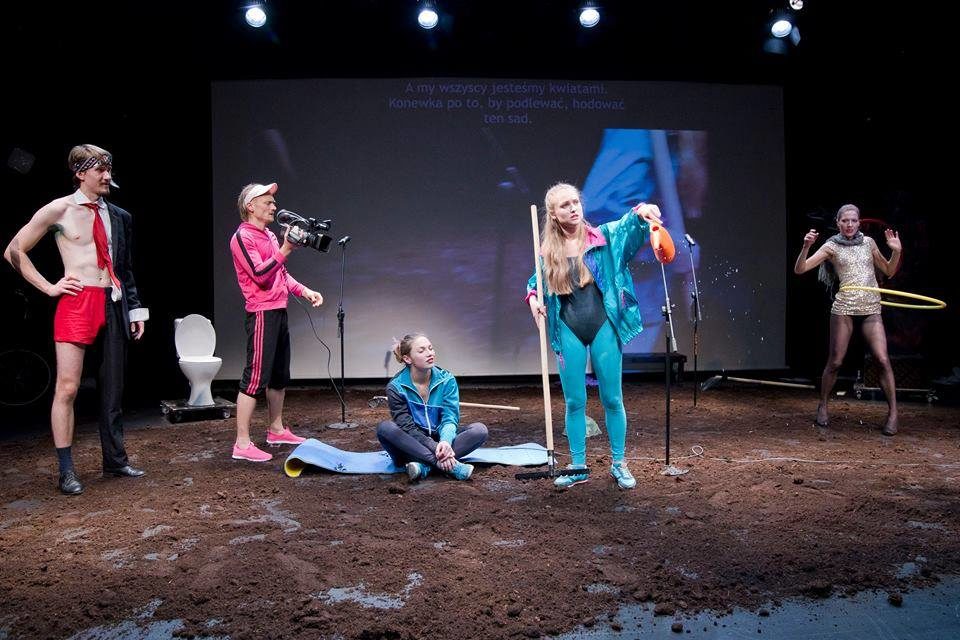
Image from My Grandfather Dug, My Father Dug, And I will Not (© Maciej Czerski)
My Grandfather Dug was shown several times in Ukraine (Lviv, Kyiv, Kharkiv), as well as during the week of the Ukrainian Critical Theatre in Poland (Desant.UA). It consists of a number of documentary personal monologues of the participants and a number of aggressive, absurd and “potent” gestures, plastic scenes. The project works with the theme of collective historical memory, post-memory and how a contemporary Ukrainian citizen defines himself in connection with it. The name here is the marker of the gap between all previous generations, whatever they are (nationalistic or Soviet, “left” or “right”), and the present, globalized generation.
A number of other projects were created with the participation of the same groups of artists: DPY (Theatre Beautiful Flowers, Dima Levitskyi, Oksana Cherkashina, Nina Khizhna) is a playback theatre with documentary monologues of soldiers and participants of the ATO (Anti-Terrorist Operation in Ukraine), rethinking the Soviet past; Restaurant Ukraine is a performance about domestic corruption (Dima Levitskyi, Oksana Cherkashina, Nina Khizhna); 4.48 Psychosis (Rosa Sarkisian, Oksana Cherkashina, Nina Khizhna, Aleksandra Malatskovskaya) is a free cabaret on the text of Sarah Kane, that won Taking the stage.
The main features of this group of works, which Ukrainian critics call “auto-thematic theatre”, or “documentary post-punk theatre” (Anastasia Gaishenets), are:
1. The absence of a hierarchy of theatrical signs; thus, any fragment can be central or culminating in the show, depending on the audience or performers;
2. The absence of the totalitarian figure of the director and, as a consequence, an open structure;
3. The rejection of the mimetic play; action instead of imitation;
4. Working with the themes of collective/historical/national memory and self-identification;
5. Kitsch and a high level of banter in relation to any of the ideologies.
The theme of memory/identity (hybrid identity), arose also on the stages of large state theatres. Stalkers in the Kyiv Young Theatre (Stas Zhirkov) became one of the most significant works of the post-Maidan period. The paradoxical and surreal text of modern Ukrainian playwright Pasha Arie depicted people who continue to live in the Chernobyl zone after the disaster, “eating” distorted myths about Coca-Cola, forced transplantation and the secret metro line built by Gorbachev. Recently, Earth, a reinterpretation of the classic text of Olga Kobylianska by David Petrosian, was shown on the stage of Ivan Franko National Academic Drama Theatre.
It seems that the topic of national identity, which is the most painful and acute topic for Ukraine, and which the “legitimate” theatre before or the state/municipal theatre today often tries to avoid, turns out every time to be the most productive stimulus to find new forms, new models of organization and self-expression. In formulating a terrible local question, “What does it mean to be Ukrainian?,” investigating the historical memory and traumas of the 20th century, the Ukrainian theatre faces the problem of the collapse of “big identities,”, the problem of the hybrid identity of a person in the modern world, the question of what it means to be a person today in general.
I would like to think that this is exactly the way in which the Ukrainian theatre will become open for dialogue.
This article originally appeared in IETM and has been reposted with permission.
This post was written by the author in their personal capacity.The opinions expressed in this article are the author’s own and do not reflect the view of The Theatre Times, their staff or collaborators.
This post was written by Elena Mygashko.
The views expressed here belong to the author and do not necessarily reflect our views and opinions.

